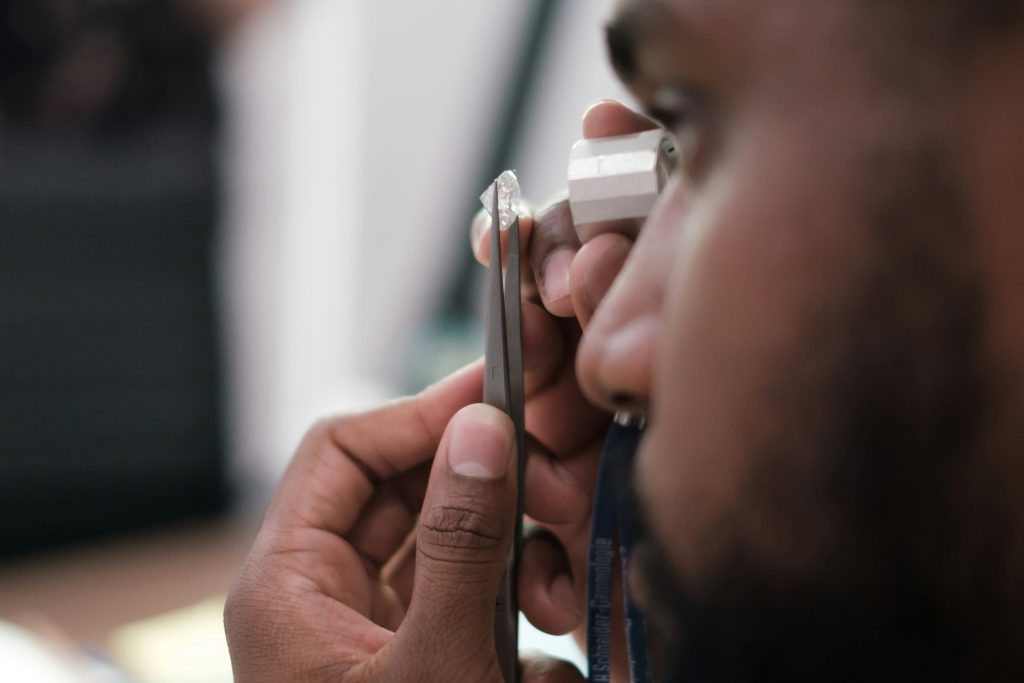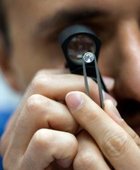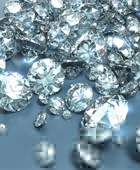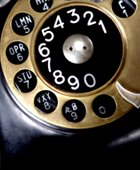A diamond appraisal is a formal process in which a certified professional evaluates your diamond’s quality, characteristics, and value. Whether you are appraising a diamond for insurance purposes, selling it, or simply want to understand its worth, knowing what to expect during the appraisal process is crucial. This article outlines the key stages of a diamond appraisal, the factors that are assessed, and how to prepare to ensure a smooth and accurate evaluation.

What Is a Diamond Appraisal?
A diamond appraisal is an official assessment of a diamond’s value conducted by a certified gemologist or appraiser. The appraisal will include a detailed analysis of the diamond’s characteristics—such as the 4 Cs (carat, cut, color, and clarity)—as well as its current market value. It is important to note that an appraisal is not the same as a diamond certification. While a certification, typically issued by a laboratory like the Gemological Institute of America (GIA), provides an objective report on the diamond’s qualities, an appraisal assigns a monetary value based on these qualities and the prevailing market conditions.
The appraisal serves multiple purposes:
- Insurance: To establish the value of a diamond for insurance coverage in case of loss, theft, or damage.
- Resale: To determine the fair market value if you are selling the diamond.
- Estate Planning: To accurately assess the value of diamonds included in estates or inheritances.
- Replacement Value: To estimate the cost of replacing a diamond with a comparable stone in case it is lost or damaged.
Appraisals can vary in terms of their scope and depth, depending on the purpose of the appraisal, but all follow a structured process to ensure accuracy.
The Diamond Appraisal Process
The diamond appraisal process involves several key steps, each of which contributes to determining the final value of the diamond. Here’s what you can expect during a professional diamond appraisal:
- Initial Consultation
When you take your diamond to an appraiser, the first step is usually an initial consultation where the appraiser will ask questions about the diamond’s history and your purpose for getting it appraised. Be prepared to provide documentation such as previous appraisals, receipts, or certificates from gemological labs (like GIA or AGS) if you have them. This information can provide the appraiser with important context that may influence their evaluation.
- Purpose of the Appraisal: The appraiser will ask whether you are getting the diamond appraised for insurance, resale, or another reason. This will help determine the type of appraisal needed (e.g., retail replacement value for insurance or fair market value for resale).
- Visual Inspection
The appraiser will perform a detailed visual inspection of the diamond using specialized equipment, such as a jeweler’s loupe, microscope, or gemological instruments, to closely examine its overall condition. This initial inspection helps the appraiser detect any visible damage, chips, or scratches, as well as confirming whether the diamond is natural or lab-grown.
- Setting Evaluation: If your diamond is mounted in a ring or other piece of jewelry, the appraiser will also evaluate the setting, considering factors like the type of metal (gold, platinum, etc.), design, craftsmanship, and overall condition. The setting can influence the overall value of the jewelry piece, though it is assessed separately from the diamond itself.
- Assessment of the 4 Cs
The cornerstone of any diamond appraisal is the assessment of the 4 Cs—carat, cut, color, and clarity. These factors are used to determine the diamond’s quality, rarity, and, ultimately, its value.
- Carat Weight: The carat weight of a diamond is one of the most important factors in determining its value. Diamonds are weighed to the nearest hundredth of a carat using precision scales. Larger diamonds are generally more valuable, but the carat weight is always considered in relation to the other three Cs.
- Cut Quality: The cut of a diamond refers to how well the stone has been shaped and faceted to reflect light. This is a critical element of a diamond’s overall beauty, as a well-cut diamond will have superior brilliance and fire. The appraiser will assess the proportions, symmetry, and polish of the diamond’s cut.
- Color Grade: Diamonds are graded on a scale from D (completely colorless) to Z (noticeable yellow or brown tint). The closer a diamond is to colorless, the higher its value. For fancy colored diamonds (e.g., pink, blue, or yellow), the intensity and evenness of the color are key value indicators.
- Clarity Grade: Clarity refers to the presence of internal flaws (inclusions) or surface imperfections (blemishes) within the diamond. Diamonds with fewer or smaller inclusions are considered more valuable. Appraisers use the 10x magnification standard to assess clarity and assign a grade from Flawless (no visible inclusions) to Included (obvious inclusions).
- Fluorescence and Other Characteristics
In addition to the 4 Cs, the appraiser will assess other characteristics that can influence the diamond’s value, such as fluorescence, which refers to the diamond’s reaction to ultraviolet light. Some diamonds exhibit a glow, typically blue, when exposed to UV light. While not always a negative trait, strong fluorescence can sometimes reduce a diamond’s value if it affects its appearance.
- Proportions and Measurements: The appraiser may also take precise measurements of the diamond’s dimensions (e.g., diameter, table size, crown height), which contribute to evaluating the quality of the cut.
- Current Market Conditions
Once the diamond’s characteristics have been evaluated, the appraiser will consider current market conditions. Diamond prices fluctuate based on demand, availability, and global economic factors. The appraiser will reference industry reports, historical data, and their own expertise to assign a value that reflects the diamond’s current market value. - Appraisal Report
After completing the examination, the appraiser will compile all the information into a formal appraisal report. This document will include detailed descriptions of the diamond’s characteristics (including the 4 Cs), any notable features, and the appraised value. The report may also include high-resolution images of the diamond for reference.
- Types of Appraisals: Depending on your purpose, the report may offer different values, such as:
- Retail Replacement Value: The cost to replace the diamond with a comparable stone, typically used for insurance purposes.
- Fair Market Value: The price a buyer would be willing to pay on the open market, often used for resale or estate purposes.
- Liquidation Value: A lower value representing the price you might receive in a quick sale, such as a pawnshop or auction.
How to Prepare for a Diamond Appraisal
Preparation is key to ensuring that your diamond appraisal is thorough and accurate. By gathering important documents, understanding the process, and choosing the right appraiser, you can help the appraisal go smoothly and get the most accurate assessment possible.
1. Gather Necessary Documentation
Before heading to the appraisal, it’s helpful to collect any existing documentation related to your diamond. While not required, these documents can provide valuable information to the appraiser and can be particularly useful if you’re uncertain about certain characteristics of your diamond. Key documents to bring include:
- Certificates from Gemological Laboratories:
If you have a certificate from a reputable lab such as the GIA (Gemological Institute of America) or the AGS (American Gem Society), this will provide important details about the diamond’s 4 Cs and other characteristics. Even if your diamond is certified, the appraiser will still perform their own evaluation, but the certificate can expedite the process. - Previous Appraisals:
If your diamond has been appraised before, bringing a copy of that report can help the appraiser compare the diamond’s condition over time. While older appraisals may not reflect current market conditions, they can still provide useful background. - Receipts or Proof of Purchase:
If you have the original receipt or proof of purchase, it can help establish when and where the diamond was bought, as well as the price paid at the time. This is especially useful for estate jewelry or inherited diamonds. - Jewelry Insurance Documents:
If your diamond is part of a piece of jewelry that’s already insured, it’s a good idea to bring your insurance policy details. This can help ensure that your appraisal reflects any requirements or expectations set by your insurance company.
2. Clean Your Diamond
Before bringing your diamond to the appraisal, it’s a good idea to clean it. A dirty or smudged diamond may appear less brilliant, which could influence the appraiser’s assessment of its cut and overall appearance. A gentle cleaning using a solution of mild soap and water can help remove any oils or residue.
- Professional Cleaning:
If you’re unsure how to properly clean your diamond or if it’s set in an intricate piece of jewelry, consider having it cleaned by a jeweler beforehand. Many jewelers offer professional cleaning services that can make your diamond look its best before the appraisal. - Home Cleaning Tips:
If you’re cleaning the diamond at home, avoid using harsh chemicals, toothpaste, or abrasive materials that could damage the setting or the diamond itself. A soft-bristled toothbrush and mild detergent are usually all you need.
3. Choose a Qualified Appraiser
Selecting a qualified and reputable appraiser is critical to receiving an accurate and fair evaluation of your diamond. Not all appraisers are equally trained or experienced, so it’s important to do your research.
- Accreditation and Certification:
Look for an appraiser who is accredited by a reputable organization, such as the American Gem Society (AGS), the National Association of Jewelry Appraisers (NAJA), or the Gemological Institute of America (GIA). Appraisers with credentials from these organizations have undergone rigorous training and adhere to industry standards. - Gemological Expertise:
Ensure that the appraiser has formal training as a gemologist, as this is essential for accurately assessing the 4 Cs and other aspects of the diamond. A GIA-certified gemologist, for example, will have the expertise needed to evaluate the diamond’s cut, clarity, color, and carat weight accurately. - Experience with Similar Diamonds:
If your diamond is particularly unique—such as a fancy-colored diamond or an antique cut—it may be worth finding an appraiser with experience evaluating similar types of diamonds. Specialized knowledge can lead to a more accurate appraisal for rare or unusual stones. - Independent Appraisers vs. Jewelers:
While some jewelers offer appraisal services, it’s often best to seek out an independent appraiser who is not affiliated with a jewelry store. Independent appraisers are less likely to have a conflict of interest and can provide a more objective evaluation.
4. Understand the Appraisal Fee Structure
Before scheduling your diamond appraisal, make sure you understand how the appraiser charges for their services. Appraisal fees can vary depending on the type of appraisal, the complexity of the diamond, and the appraiser’s experience. Typical fee structures include:
- Flat Fee:
Some appraisers charge a flat fee based on the type of jewelry being appraised. For example, they may have a set price for appraising a diamond ring, bracelet, or necklace. - Hourly Rate:
Other appraisers charge by the hour, particularly for complex pieces or large collections. An hourly rate is typically more transparent, as it prevents the appraiser from inflating the diamond’s value to increase their fee. - Avoid Percentage-Based Fees:
Be cautious of appraisers who charge based on a percentage of the appraised value. This can create a conflict of interest, as the appraiser may be incentivized to inflate the diamond’s value.
Understanding the fee structure in advance will help you avoid unexpected costs and ensure you are paying for a professional and unbiased appraisal.
5. Know What to Expect from the Final Appraisal Report
At the end of the appraisal, the appraiser will provide a formal written report that details their findings and assigns a value to the diamond. The report should include several key components to ensure its accuracy and usefulness:
- Detailed Description of the Diamond:
The report should provide a comprehensive description of the diamond, including its carat weight, cut, color, clarity, and any other notable characteristics such as fluorescence or unique inclusions. - Photographs:
High-resolution images of the diamond may be included in the report, which can be helpful for both insurance purposes and personal reference. - Appraised Value:
The appraiser will assign a value to the diamond based on its characteristics, the current market conditions, and the purpose of the appraisal (e.g., insurance vs. resale). Make sure the appraised value is clearly stated in the report. - Date of Appraisal and Appraiser’s Credentials:
The report should include the date of the appraisal and the credentials of the appraiser, such as their certification or accreditation from a reputable gemological organization. This ensures that the appraisal is current and performed by a qualified professional.
Common Pitfalls to Avoid During a Diamond Appraisal
While the appraisal process is generally straightforward, there are a few common mistakes that can lead to inaccurate results or complications. Here are some pitfalls to avoid:
- Not Updating Appraisals Regularly:
If your diamond has not been appraised in several years, it’s likely that the value has changed due to market fluctuations. For insurance purposes, it’s recommended to have your diamond appraised every 3-5 years to ensure you have accurate and up-to-date coverage. - Relying Solely on Certificates:
While certificates from gemological labs are important, they do not provide a value for the diamond. A certificate is not a substitute for an appraisal, so don’t skip the appraisal process even if your diamond is certified. - Choosing an Unqualified Appraiser:
Selecting an appraiser who is not certified or who lacks experience can result in an inaccurate appraisal. Always check the credentials and reputation of the appraiser before proceeding.
Conclusion: The Importance of a Professional Diamond Appraisal
Getting your diamond appraised by a certified professional provides you with a detailed understanding of its value and quality. Whether for insurance, resale, or estate planning purposes, an accurate appraisal ensures that your diamond is protected and properly valued. By preparing in advance, selecting a qualified appraiser, and understanding the key elements of the appraisal process, you can make the most of your diamond appraisal and gain valuable insights into your gemstone’s worth.




